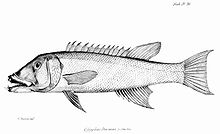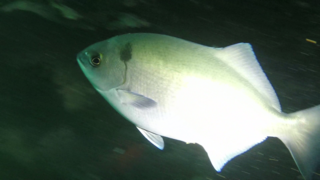
The halfmoon, also known as the blue perch, is a species of marine ray-finned fish, a sea chub from the subfamily Scorpidinae, part of the family Kyphosidae. It is native to the coasts of the eastern Pacific Ocean off western North America. It is fished for using hook and line and it is a desirable food fish.

The bat ray is an eagle ray found in muddy or sandy sloughs, estuaries and bays, kelp beds and rocky-bottomed shoreline in the eastern Pacific Ocean, between the Oregon coast and the Gulf of California. It is also found in the area around the Galápagos Islands. The largest specimens can grow to a wingspan of 1.8 m and a mass of 91 kg (201 lb). They more typically range from 9.07–13.61 kg (20.0–30.0 lb). The size of the bat ray is dependent on many factors, such as habitat alterations, different oceanographic and environmental conditions. Bat rays have one to three venomous barbed spines at the base of its tail. Some bat rays are solitary while others form schools numbering in the thousands.

Paralabrax clathratus, the kelp bass, bull bass or calico bass, is a species of marine ray-finned fish, a sea bass from the subfamily Serraninae, classified as part of the family Serranidae which includes the groupers and anthias. It is found in the eastern North Pacific Ocean where it is an important species for both recreational and commercial fisheries.

Semicossyphus is a genus of wrasses native to the Pacific Ocean.

The red-lipped batfish or Galapagos batfish is a fish of unusual morphology found around the Galapagos Islands and off Peru at depths of 3 to 76 m. Red-lipped batfish are closely related to rosy-lipped batfish, which are found near Cocos Island off the Pacific coast of Costa Rica. This fish is mainly known for its bright red lips. Batfish are not good swimmers; they use their highly adapted pectoral, pelvic and anal fins to "walk" on the ocean floor. When the batfish reaches maturity, its dorsal fin becomes a single spine-like projection.

Cephalopholis panamensis, the Pacific graysby or Panama graysby, is a species of marine ray-finned fish, a grouper from the subfamily Epinephelinae which is in the family Serranidae which also includes the anthias and sea basses. It is found in the Eastern Pacific Ocean.

Scorpaena afuerae, the Peruvian scorpionfish, is a species of marine ray-finned fish belonging to the family Scorpaenidae, the scorpionfishes. This species is found in the eastern Pacific Ocean.

The sixbar wrasse or six-banded wrasse is a species of wrasse in the family Labridae, native to the Indian Ocean and the western Pacific Ocean. It is an inhabitant of reef environments at depths from the surface down to 15 m (50 ft). This species can grow to 20 cm (8 in) in total length, though most individuals do not exceed 15 cm (6 in). It is of minor importance to local commercial fisheries and can also be found in the aquarium trade.
Darwini, a New Latin adjective that commonly refers to Charles Darwin, may refer to:
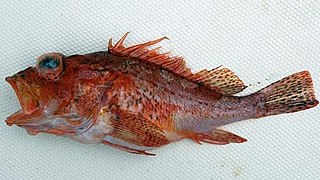
Pontinus furcirhinus, one of a number of species known as the "red scorpionfish", is a species of marine ray-finned fish belonging to the family Scorpaenidae, the scorpionfishes. It is found in the eastern Pacific Ocean.

The ocean whitefish, also known as the ocean tilefish, is a species of marine ray-finned fish, a tilefish belonging to the family Malacanthidae. It is native to the eastern Pacific Ocean.
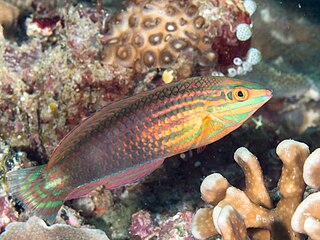
The red-lined wrasse, two-spotted wrasse or biocellated wrasse, Halichoeres biocellatus, is a species of wrasse native to shallow tropical waters in the western Pacific Ocean.

Oxyjulis californica is a species of wrasse native to the eastern Pacific Ocean along the coasts of California and Baja California. Its distribution extends from Salt Point in Sonoma County, California, to southern central Baja California, near Cedros Island. It is a very common species; its common name in Spanish is señorita.
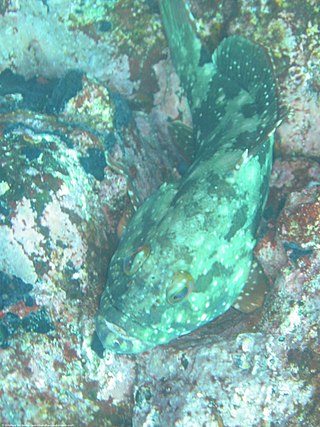
Epinephelus labriformis, commonly called starry grouper or flag cabrilla is a species of marine ray-finned fish, a grouper from the subfamily Epinephelinae which is part of the family Serranidae, which also includes the anthias and sea basses. It is found in the eastern Pacific Occean.

Graus nigra is a species of sea chub endemic to the Pacific coast of South America, ranging from Valdivia in Chile to southern Peru. This species grows to a total length of 64.6 cm (25.4 in). It is popular as a game fish. This species is the only known member of its genus, and is known locally as vieja negra.

Chirodactylus variegatus, the Peruvian morwong or bilagai, is a species of marine ray-finned fish traditionally regarded as belonging to the family Cheilodactylidae, the members of which are commonly known as morwongs. It is found in the southeastern Pacific Ocean off the western coast of South America.
Medialuna ancietae is a species of sea chub native to the Pacific coast of South America where it inhabits the [[Macrocystis pyrifera|giant kelp forests. It is known locally as acha, mero del sur or chino.

Pinguipes chilensis, commonly known as the Chilean sandperch, is a species of ray-finned fish in the family Pinguipedidae. It is found in the southeastern Pacific Ocean off the coasts of Peru and Chile.
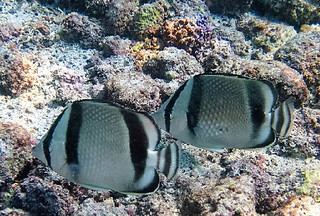
Chaetodon humeralis, the threebanded butterflyfish, is a species of marine ray-finned fish, a butterflyfish belonging to the family Chaetodontidae. It is found in the eastern Pacific Ocean.

Aplodactylus punctatus, the Zamba marblefish, is a species of marine ray finned fish, one of the marblefishes belonging to the family Aplodactylidae. It is found in the eastern Pacific Ocean of the west coast of South America.
